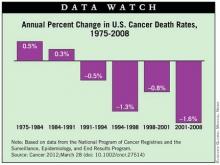Fewer people are being diagnosed with and dying from cancer in the United States, thanks to advances in prevention, diagnosis, and treatment, but the growing obesity problem may slow the downward trend, according to an annual report to the nation.
Between 1999 and 2008, the rates of death from cancer decreased by an average of 1.7% per year for men, 1.3% per year for women, and 1.5% per year for children, investigators reported online ahead of print on March 29 in Cancer. All four of the most common cancers – lung, colorectal, breast, and prostate – had declines in their death rates.
The incidence rates for several cancers associated with excess weight and lack of sufficient physical activity increased during the period of study, however. These included pancreatic cancer, kidney cancer, and adenocarcinomas of the esophagus.
Tobacco prevention and control contributed to the falling death rates, but more needs to be done on multiple levels to promote healthy weight and physical activity, concluded Christie Eheman, Ph.D., of the Centers for Disease Control and coauthors of the Annual Report to the Nation on the Status of Cancer, 1975-2008.
The report represents a collaboration of the CDC, the American Cancer Society, the National Cancer Institute, and the North American Association of Central Cancer Registries.
Cancer Incidence Declined in Adults but Rose in Children
Overall cancer incidence decreased by an average 0.6% among men from 1994 to 2008 and by an average of 0.5% among women from 1998 to 2006, remaining stable in 2006-2008.
In children, however, overall cancer incidence increased annually in 1998-2008 by 0.5% among children 0-14 years and by 0.6% among those 0-19 years, the authors wrote (Cancer 2012, March 29 [doi: 10.1002/cncr.27514]).
By individual cancer site, the incidence of colorectal and prostate cancers, as well as lung cancer in men, decreased during the 10-year and most recent 5-year (2004-2008) periods included in the report. The incidence of lung cancer in women also declined from 2004 to 2008.
During the same 5- and 10-year periods, "death rates increased for pancreatic cancer among both men and women, for liver cancer and melanoma of the skin among men, and for corpus uterus [uterine] cancer among women." Cervical cancer death rates saw little change, according to the authors.
Kidney cancer incidence increased across racial and ethnic groups in 1999-2008 by approximately 2.9% among men and 3.3% among women.
The incidence of pancreatic cancer increased by approximately 1.2% over the 10 years in white men and women; the incidence of uterine cancer increased significantly among black, Asian and Pacific Islander, and Hispanic women during that time.
Adenocarcinoma of the esophagus increased 2.6% annually among white and Hispanic men and 3.3% among white women.
Among racial and ethnic groups, in 2004-2008, black men and white women had the highest rates of cancer incidence, and black men and black women had the highest cancer mortality rates. These discrepancies could reflect differences in risk factors as well as access to and use of screening and treatment, the authors stated.
Progress Noted but With a Cautionary Note
The continued declines in overall cancer death rates since the 1990s among men and women overall and in nearly all racial and ethnic groups "indicate progress in cancer prevention and control," the authors wrote. "These decreases are largely a result of tobacco prevention and control efforts, screening and early detection of some cancers, and improvements in treatment for many cancers."
Despite improvements in the overall cancer burden, however, "excess weight and lack of sufficient physical activity contribute to the increased incidence of many cancers, adversely affect quality of life for cancer survivors, and may worsen prognosis for several cancers," they said.
As such, efforts to promote healthy weight and sufficient physical activity must be undertaken at multiple levels, rather than solely at the level of the individual, they stressed:
"Supporting recommended healthy lifestyle behaviors will require concerted actions from individuals; communities; the media; federal, state, and local governments; food industries; international agencies; and sectors beyond what is usually considered public health, such as transportation and agriculture."
Importantly, the authors concluded, "quality, population-based risk factor and cancer surveillance data can be used to identify areas and populations with unhealthy behaviors and high cancer rates that could benefit from targeted, effective strategies and interventions to improve health behaviors and support healthy environments."
Data on cancer incidence came from the CDC, NCI, and NAACCR, and data on cancer mortality from the CDC National Center for Health Statistics.
The authors disclosed no conflicts of interest.


